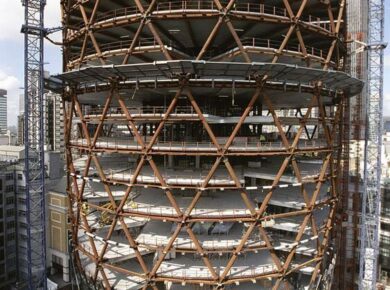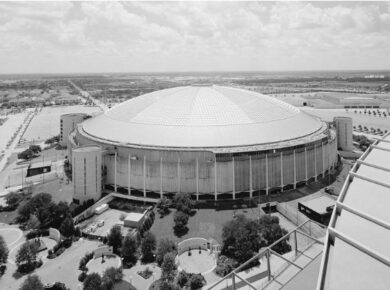‘Dit is mijn huis, dit is mijn deur’
Robert R. Bruno Jr. (January 30, 1945 – December 9, 2008) was an American artist, inventor, and engineer. In 1982, he designed and created one of the first solar-powered surge irrigation systems for row crops.

Photograph by Laura Wilson
Bruno had been making sculptures out of steel since the sixties, when he was an art student at the Dominican College of Racine, a now-defunct Catholic school in Wisconsin. Over time his works grew larger and larger, eventually resulting in a massive, angular, four-legged sculpture he made after moving to Lubbock.

Photo: Courtesy of Robert Bruno
The huge piece, with its thrusting, cyborglike snout, is beautifully pieced together from a patchwork of small pieces of Cor-ten steel.

Photograph by Laura Wilson
Bruno began construction of the Steel House in 1973. It is estimated to weigh 110 tons and rests on four hollow legs anchored to the eastern rim of Yellow House Canyon. The steel house has many large smoothly curving windows, some composed of stained glass while others provide a panoramic view of Lake Ransom Canyon. It remained unfinished at his death.

Photograph by Laura Wilson
For decades, the edifice, also known as the Steel House, has been a part of Lubbock folklore, a local curiosity that students at Texas Tech University learn about through word of mouth and make short pilgrimages to see. It’s instantly recognizable: a gravity-defying, rusted, bulbous steel pod on four legs that’s served as the backdrop for a Vogue fashion shoot as well as a music video by Solange.

Photo: Troy Oxford / Dallas Morning News
Perched on a hillside, the structure has been compared to a pachyderm, the hull of a spaceship, and, in the words of Dallas Morning News architecture critic Mark Lamster, “the kind of house a James Bond villain might occupy.”
About the Author:

Bruno Dursin – Managing Director at Believe in Steel. Bruno has more than 30 years of experience in promoting steel & steel solutions. His clients benefit from his extensive network within the building industry.



